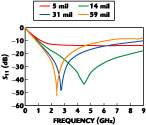Product Feature
Advanced Microwave Chip Capacitor Models
Modelithics Inc.
Temple Terrace, FL
|
|
|
Fig. 1 Measured S11 of a 4.7 pF 0402 chip capacitor on different thickness FR4 substrates (series configuration). |
The use of computer-aided engineering (CAE) software by microwave printed circuit board (PCB) designers has become commonplace. These powerful tools are indispensable for rapid design, statistical analysis and trouble-shooting in the product development cycle. As apparent as the need for robust and versatile platforms, however, is the necessity for accurate component models on which the simulations rely. This article discusses some critical attributes of chip capacitor models, some of which both component manufacturers and PCB designers often overlook.
Perhaps the most ominous deficiency (from the circuit designer's perspective) in many chip capacitor models is a lack of accurate means by which to incorporate substrate-dependence. In a physical sense, a multi-layer capacitor can be considered a complex, strip-like transmission line with the PCB back-plane serving as its ground. An accurate circuit model for the capacitor must emulate the adjacent ground effects, and scale appropriately as the substrate parameters (thickness and dielectric constant) vary. This scaling applies not only to shunt capacitance, but to other parasitic elements, such as series inductance. Figure 1 illustrates the substrate-dependence of a 4.7 pF 0402 style capacitor series-mounted on different FR4 substrates. The effect of substrate thickness on the self-resonance of the part is dramatic.
|
|
|
Fig. 2 S11 of a 15 pF 0805 chip capacitor on different thickness GR4 substrates showing higher order resonance effects (series configuration). |
Bandwidth, or range of model validity, is another important characteristic of CAE models in general. A model that extends far beyond the "design" frequency can prevent miscalculations regarding out-of-band effects and may even prevent over- (or under-) specification of filtering requirements. A nonlinear simulation involving multiple harmonics of the fundamental is another example pointing to the need for high frequency accuracy. For capacitor values greater than a few pico-Farads, broadband accuracy through 10 GHz typically requires models that will predict multiple higher order resonances. Figure 2 includes the measured S11 response of a 15 pF 0805 style capacitor on 5, 14, 31 and 59 mil-thick FR4, comparing these results to an accurate Modelithics broadband model and typical supplier data.
Advanced chip capacitor models enable effective use of today's powerful CAE software in PCB design. Equivalent circuit topologies are far superior to the (S-parameter) data file approach. Among other things, circuit models provide accurate representation of the effective series resistance (ESR) and substrate effects, and they eliminate frequency-extrapolation problems that can occur as the frequency is swept beyond the limits of a data file. This article also illustrates the importance of capacitor models that incorporate substrate-dependence and have broadband accuracy.
Accurate substrate-dependent models for a wide range of capacitor vendors and nominal values are available for licensing. The models are provided with extensive validation data. For more information, contact sales@modelithics.com.
Modelithics Inc., Temple Terrace, FL (813) 866-6335, www.modelithics.com.
Circle No. 303


